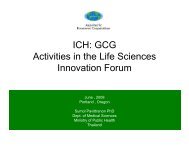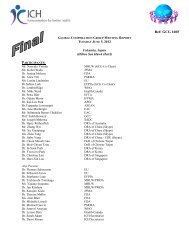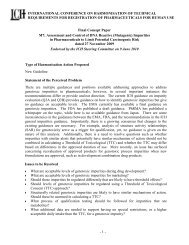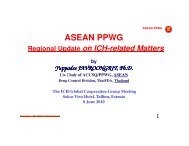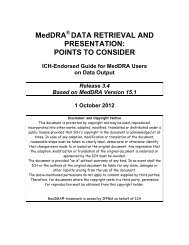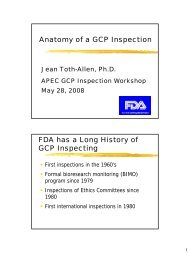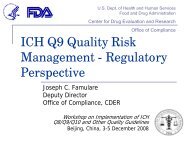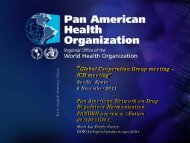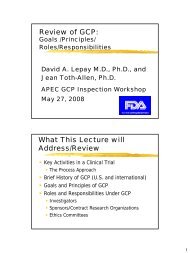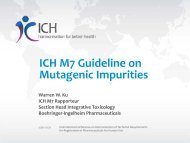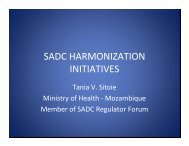Presentation on S7A - ICH
Presentation on S7A - ICH
Presentation on S7A - ICH
Create successful ePaper yourself
Turn your PDF publications into a flip-book with our unique Google optimized e-Paper software.
GUIDELINE ON SAFETY<br />
PHARMACOLOGY STUDIES<br />
FOR HUMAN<br />
PHARMACEUTICALS (<strong>S7A</strong>)<br />
<strong>ICH</strong> S7 Expert Working Group<br />
M. Hashimoto Ph.D.<br />
Pharmacia<br />
<strong>ICH</strong>-5 November 10, 2000
Efficacy<br />
Guideline <strong>on</strong><br />
Safety Pharmacology<br />
Studies<br />
Safety<br />
<strong>ICH</strong>-CTD<br />
Definiti<strong>on</strong>:<br />
Primary, Sec<strong>on</strong>dary<br />
Pharmaco-dynamics<br />
Safety Pharmacology<br />
<strong>ICH</strong>-M3<br />
Timing to Clinical<br />
Studies<br />
Step 1: Mar. 1999<br />
Aug. 1999<br />
Oct. 1999<br />
Step 2: Mar. 2000<br />
Sep. 2000<br />
Step 4: Nov. 2000<br />
Guideline<br />
<strong>ICH</strong>-5 November 10, 2000<br />
Internati<strong>on</strong>al Discussi<strong>on</strong><br />
(Symposium <strong>on</strong><br />
(General/Safety Pharmacology)<br />
Hierarchical order<br />
:Core<br />
:Follow-up<br />
:Supplemental<br />
Applicati<strong>on</strong> of GLP
Table of C<strong>on</strong>tent<br />
1. INTRODUCTION<br />
1.1 Objectives Of The Guideline<br />
1.2 Background<br />
1.3 Scope Of The Guideline<br />
1.4 General Principle<br />
1.5 Definiti<strong>on</strong> Of Safety Pharmacology<br />
2. Guideline<br />
2.1 Objectives Of Studies<br />
2.2 General C<strong>on</strong>siderati<strong>on</strong> In<br />
Selecti<strong>on</strong>/Design<br />
2.3 Test Systems<br />
2.4 Dose Levels/C<strong>on</strong>centrati<strong>on</strong>s<br />
2.5 Durati<strong>on</strong> Of Studies<br />
2.6 Metabolites, Isomers, Finished Products<br />
2.7 Core Battery<br />
2.8 Follow-up And Supplemental Studies<br />
2.9 C<strong>on</strong>diti<strong>on</strong>s Under Which Studies Are Not<br />
Necessary<br />
2.10 Timing In Relati<strong>on</strong> To Clinical<br />
Development<br />
2.11 Applicati<strong>on</strong> Of GLP<br />
3. Notes (Note 3 : QT issues, S7B)<br />
<strong>ICH</strong>-5 November 10, 2000
Major Points of Guideline<br />
• Definiti<strong>on</strong><br />
• Rati<strong>on</strong>al Approach<br />
• Core Battery, Follow-up and Supplemental<br />
Safety Pharmacology Studies Based <strong>on</strong><br />
Hierarchical Order of Organ Systems<br />
• Investigati<strong>on</strong> in Relati<strong>on</strong> to Systemic Exposure<br />
• C<strong>on</strong>siderati<strong>on</strong>s for Dose Selecti<strong>on</strong><br />
• Timing in Relati<strong>on</strong> to Clinical Development<br />
• GLP Applicati<strong>on</strong><br />
<strong>ICH</strong>-5 November 10, 2000
Definiti<strong>on</strong> of SP<br />
• Studies that investigate the potential<br />
undesirable pharmacodynamic effects<br />
<strong>on</strong> physiological functi<strong>on</strong>s in relati<strong>on</strong><br />
to exposure in the therapeutic range<br />
and above<br />
• Primary: Studies <strong>on</strong> the mode of acti<strong>on</strong> and or<br />
effects in relati<strong>on</strong> to the desired therapeutic target<br />
• Sec<strong>on</strong>dary: Studies <strong>on</strong> the mode of acti<strong>on</strong> and/or<br />
effects not related to the desired therapeutic target<br />
<strong>ICH</strong>-5 November 10, 2000
Scope of Guideline<br />
New chemical entities<br />
Biotechnology-derived products<br />
Marketed pharmaceuticals when<br />
appropriate<br />
<strong>ICH</strong>-5 November 10, 2000
General SP Principles<br />
• Rati<strong>on</strong>al Approach in Design and C<strong>on</strong>duct<br />
Based <strong>on</strong> Pharmaceutical’s Properties and<br />
Uses<br />
• Scientifically Valid Methods<br />
• Use of New Technologies and Methodologies<br />
is Encouraged<br />
• Potential to Incorporate SP Endpoints into<br />
Toxicology, Kinetics, Clinical studies etc.<br />
<strong>ICH</strong>-5 November 10, 2000
Objectives of SP Studies<br />
• Identify undesirable pharmacodynamic<br />
properties relevant to human safety<br />
• Evaluate adverse pharmacodynamic effects<br />
observed in toxicology and/or clinical studies<br />
• Investigate mechanisms of adverse<br />
pharmacodynamic effects<br />
<strong>ICH</strong>-5 November 10, 2000
Route(s) of Administrati<strong>on</strong><br />
• Clinical route preferred<br />
• Exposure achieved similar to or greater<br />
than in humans<br />
• If clinical use involves multiple routes,<br />
c<strong>on</strong>sider more than <strong>on</strong>e route<br />
<strong>ICH</strong>-5 November 10, 2000
Durati<strong>on</strong> of Studies<br />
• Generally single dose<br />
• C<strong>on</strong>sider repeat dose when:<br />
- PD effect <strong>on</strong>ly after a certain durati<strong>on</strong><br />
- C<strong>on</strong>cerns from repeat dose n<strong>on</strong>clinical<br />
studies and human use<br />
<strong>ICH</strong>-5 November 10, 2000
Safety Pharmacology Core<br />
Battery<br />
• Focus <strong>on</strong> Vital Functi<strong>on</strong>s<br />
- Central Nervous System<br />
- Cardiovascular System<br />
- Respiratory System<br />
<strong>ICH</strong>-5 November 10, 2000
Safety Pharmacology Core<br />
Battery (c<strong>on</strong>tinued)<br />
Central Nervous System<br />
• Motor activity<br />
• Behavioral changes<br />
• Coordinati<strong>on</strong><br />
• Sensory/motor reflex resp<strong>on</strong>ses<br />
• Body temperature.<br />
(e.g. FOB, Irwin’s test, Neurotoxicity testing)<br />
<strong>ICH</strong>-5 November 10, 2000
Safety Pharmacology Core<br />
Battery (c<strong>on</strong>tinued)<br />
Cardiovascular System<br />
• Blood pressure, heart rate, ECGs.<br />
• C<strong>on</strong>sider in vivo, in vitro and/or ex vivo<br />
evaluati<strong>on</strong>s including methods for<br />
repolarizati<strong>on</strong> and c<strong>on</strong>ductance abnormalities<br />
(S7B Guideline will follow: Panel discussi<strong>on</strong>)<br />
<strong>ICH</strong>-5 November 10, 2000
Safety Pharmacology Core<br />
Battery (c<strong>on</strong>tinued)<br />
Respiratory System<br />
• Clinical observati<strong>on</strong> al<strong>on</strong>e generally not<br />
adequate<br />
• Quantitative measurement of respiratory rate<br />
and other measures (tidal volume or<br />
hemoglobin oxygen saturati<strong>on</strong>)<br />
<strong>ICH</strong>-5 November 10, 2000
Follow-up and Supplemental<br />
SP Studies<br />
C<strong>on</strong>sider when:<br />
• Adverse effects suspected based <strong>on</strong> the<br />
pharmacological properties and chemical class<br />
• C<strong>on</strong>cerns from the safety pharmacology core<br />
battery, clinical trials, pharmacovigilance,<br />
experimental in vitro or in vivo studies, or from<br />
literature reports<br />
<strong>ICH</strong>-5 November 10, 2000
Follow-up Studies<br />
• Case-by-case<br />
• Provide a greater depth of understanding<br />
• List provided not comprehensive or<br />
prescriptive<br />
• In some cases more appropriate to address<br />
effects in other n<strong>on</strong>-clinical and/or clinical<br />
studies<br />
<strong>ICH</strong>-5 November 10, 2000
Supplemental Studies<br />
• Other organ systems not addressed by core<br />
battery<br />
- Renal/Urinary System<br />
- Aut<strong>on</strong>omic Nervous System<br />
- Gastrointestinal System<br />
<strong>ICH</strong>-5 November 10, 2000
C<strong>on</strong>diti<strong>on</strong>s Under Which Studies<br />
Are Not Necessary<br />
• Some locally applied agents (e.g. dermal or<br />
ocular)<br />
• Some cytotoxic agents for treatment of endstage<br />
cancer patients<br />
• Some biotechnology-derived products<br />
• Some other cases based <strong>on</strong> PK and PD<br />
<strong>ICH</strong>-5 November 10, 2000
Timing in Relati<strong>on</strong> to Clinical<br />
Development<br />
• Prior to first administrati<strong>on</strong> in humans<br />
Core battery<br />
Follow-up and supplemental based <strong>on</strong> a cause for c<strong>on</strong>cern<br />
• During clinical trial<br />
To clarify observed undesirable effects in animals and humans<br />
• Before approval<br />
Supplemental studies unless not warranted.<br />
- Justify<br />
- SP endpoints covered in other studies<br />
<strong>ICH</strong>-5 November 10, 2000
<strong>S7A</strong> Panel Discussi<strong>on</strong><br />
Dr. J. DeGeorge: Dose Selecti<strong>on</strong><br />
Dr. J. Moe: Metabolites, Isomers And<br />
Finished Products<br />
Dr. K. Fujimori: Good Laboratory Practice<br />
Dr. K. Olejniczak: Future Activities : S7B<br />
QT/Torsade<br />
<strong>ICH</strong>-5 November 10, 2000
Dose Levels In Vivo<br />
• Define dose-resp<strong>on</strong>se<br />
• Include and exceed primary PD or<br />
therapeutic range<br />
• Absent adverse effect <strong>on</strong> SP parameter,<br />
use dose producing moderate adverse<br />
effects in this or in other (toxicology)<br />
studies of similar route and durati<strong>on</strong><br />
<strong>ICH</strong>-5 November 10, 2000
Metabolites<br />
• C<strong>on</strong>sider SP Studies When Metabolites:<br />
- Achieve systemic exposure in humans<br />
- Are absent or at low c<strong>on</strong>centrati<strong>on</strong> in animals<br />
- C<strong>on</strong>tribute to pharmacological activity<br />
• In Vitro Test Systems Can Be Used Based On<br />
Practical C<strong>on</strong>siderati<strong>on</strong>s<br />
<strong>ICH</strong>-5 November 10, 2000
Isomers and Finished<br />
Products<br />
• C<strong>on</strong>sider SP Testing Of:<br />
- Individual isomers in an isomeric mixture<br />
- New formulati<strong>on</strong>s that substantially alter PK or PD<br />
of finished product<br />
<strong>ICH</strong>-5 November 10, 2000
N<strong>on</strong>-GLP<br />
GLP<br />
Applicati<strong>on</strong> of GLP<br />
Applicati<strong>on</strong> of GLP<br />
Safety Pharmacology Studies = Safety Studies<br />
• NOT GLP<br />
- Primary PD Studies<br />
- Sec<strong>on</strong>dary PD when not pivotal to safety<br />
• Ordinarily GLP<br />
- Core battery<br />
- SP endpoints from toxicology studies<br />
- Sec<strong>on</strong>dary PD studies when pivotal *<br />
• GLP to the greatest extent feasible<br />
- Supplemental, Follow-up<br />
* When results significantly c<strong>on</strong>tribute to safety evaluati<strong>on</strong> for human<br />
potential adverse effects <strong>ICH</strong>-5 November 10, 2000
N<strong>on</strong>-GLP<br />
GLP<br />
Implementati<strong>on</strong> of GLP<br />
Implementati<strong>on</strong> of GLP<br />
• Excepti<strong>on</strong>s<br />
- Unique design<br />
- Practical c<strong>on</strong>siderati<strong>on</strong><br />
• Data quality and integrity<br />
In the absence of formal adherence to the<br />
Principle of GLP<br />
- Ensure study rec<strong>on</strong>structi<strong>on</strong><br />
- Provide rati<strong>on</strong>ale<br />
- Explain impact<br />
<strong>ICH</strong>-5 November 10, 2000
S7B<br />
N<strong>on</strong>-clinical Approaches for<br />
Predicting Torsade de Pointes<br />
Objectives:<br />
To outline available n<strong>on</strong>clinical methodologies<br />
for assessment of potential ventricular<br />
tachyarrhythmia<br />
To discuss the advantages and disadvantages of<br />
the systems and models.<br />
<strong>ICH</strong>-5 November 10, 2000
S7B<br />
N<strong>on</strong>-clinical Approaches for<br />
Predicting Torsade de Pointes<br />
Current state of guidance<br />
CPMP “Points to C<strong>on</strong>sider" document<br />
Publicati<strong>on</strong>s<br />
Systems/Models available:<br />
Advantages and Limitati<strong>on</strong>s of each<br />
- Heterologous expressi<strong>on</strong> systems<br />
- Disaggregated cells<br />
- Isolated tissue<br />
- Isolated intact heart (Langendorff)<br />
- Intact animal (e.g., Guinea pig, rabbit, dog, pig)<br />
<strong>ICH</strong>-5 November 10, 2000
General C<strong>on</strong>siderati<strong>on</strong> in Selecti<strong>on</strong><br />
and Design<br />
• Therapeutic class (e.g. proarrhythmia of antiarrhythmic<br />
agents)<br />
• Members of the chemical or therapeutic class but<br />
independent of primary PD effects (e.g. anti-psychotics<br />
and QT prol<strong>on</strong>gati<strong>on</strong>)<br />
• Ligand binding or enzyme assay<br />
• Results from Previous SP, sec<strong>on</strong>dary PD, tox studies, or<br />
from human use<br />
• Hierarchy: life-supporting system (CNS, CVS, Resiratory)<br />
Other organ systems when c<strong>on</strong>sidering factors, e.g.,<br />
clinical trial or patient populati<strong>on</strong><br />
<strong>ICH</strong>-5 November 10, 2000




